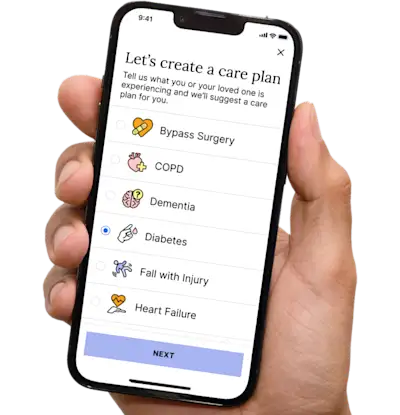How Do I Prevent a UTI in My Loved One?
Things you can do to keep your loved one from getting a UTI may surprise you. It's more than good care down there!
Get insurance benefits, legal documents, and medical records in one place

Helpful Highlights
Older adults are at higher risk for UTI and it is one of the most commonly diagnosed infections in this population.
Good toileting hygiene is a cornerstone of UTI prevention, though for older adults more can and should be done.
Getting mobile and staying active actually helps combat UTI risk, even if your loved one has some form of incontinence.
Urinary tract infection (UTI) is one of the most commonly diagnosed infections in older adults, and you might have heard that the best sign of a urinary tract infection (UTI) in an older person is a sudden behavioral change or sudden onset of confusion. In fact, this is still reported in many resources on the subject. However, behavior change or confusion is actually a late sign of UTI. Once these symptoms occur, the UTI has already taken hold of their system and can be harder to treat.
How can I prevent my loved one from getting a UTI?
Help them manage chronic conditions, especially diabetes. Diabetes increases the risk of UTI by n-times. Staying on top of chronic conditions prevents those conditions from weakening your loved one’s immune system, depleting their body of oxygen and nutrients, and causing other health problems that make them more vulnerable to infection.
Help them stay hydrated. Older adults are at higher risk of dehydration, which is an open invitation for harmful organisms and creates a breeding ground for them, especially in the bladder because it isn’t being freshly filled and flushed regularly. Hydrating with clear liquids is always best – water, water, water, clear fruit juices, black coffee or tea (no milk or cream), and broths. *Note that flavored water additives are fine, though sports drinks are not recommended because of high sodium and added sugar content.
Reduce sugar intake. Excess sugar can contribute to UTI. The bacteria that cause UTIs love sugar. Sugar increases the acid level of urine, creating a growth environment for this bacteria and facilitating infection. Encourage your loved one to avoid frequent sugary drinks, snacks, processed foods, and desserts. Likewise, choosing low-acidity fruits and drinks is best.
Help them develop a regular toileting schedule. Oftentimes, older adults will engage in what’s called “nesting,” whereby they gather all the things they will need for the day to their favorite spot in the house – a recliner or sofa in front of the TV, a rocking chair on the porch or in the sunroom, a workbench in the garage or shop – and will remain seated there for hours at a time. This promotes urine retention and, for those with any type of incontinence, sitting for prolonged periods in soiled briefs.
Help them get mobile. Walking strengthens pelvic muscles, including the bladder, and promotes kidney function and regular toileting. The more mobile your loved one is, the more likely they are to increase circulation, lubricate joints, and reduce overall disease risk, and the less likely they are to experience complications from urinary incontinence or retention that lead to infection.
Help them stay clean. Good toileting hygiene remains essential to UTI prevention. Ensure your loved one is practicing proper wiping after toileting (front to back, and moist towelettes are helpful), that they are thoroughly cleaning their nether regions when bathing, and that they are changing wet or soiled incontinence products as quickly as possible. *Note: Do not use baby powder, talcum powder, deodorants, or any scented products (soaps, lotions, sprays) in this region as they are skin irritants and do more harm than good.
The next best thing to preventing UTI is catching it as early as possible, and while signs and symptoms of UTI in older adults may overlap, they can also differ from those considered common. Unique indicators of UTI in older adults include:
Decreased appetite
Difficulty sleeping, possibly including night sweats
New or increased urinary incontinence
Change in sensation with urination that isn’t necessarily burning or pain, such as:
Pressure
Numbness
Itching
Spasms
A feeling of bladder fullness even after urination
Discolored, cloudy, and/or odorous urine
Pelvic pain
Swelling or tenderness in the genitals (especially testes in males)
Why are older adults at higher risk?
UTIs are common in the elderly and cover a range of conditions from asymptomatic bacteriuria [see When is Bacteria in Urine NOT a Urinary Tract Infection?] to urosepsis (dysfunctional immune response to UTI requiring hospitalization).
Risk factors for developing symptomatic UTIs include immunosenescence (immune system breakdown that occurs with age), exposure to hospital pathogens, comorbidities, and history of UTIs, which are characteristics most common to older adults and the elderly.
RESOURCES
Becker's Clinical Leadership & Johns Hopkins
Jepson, R.G., Williams, G., & Craig, J.C. (Eds.). (2012). Cranberries for preventing urinary tract infection. Cochrane Database of Systematic Reviews, 2012(10): CD001321. doi: 10.1002/14651858.CD001321.pub5
National Association for Continence (NAFC)
Rodriguez-Manas, L. (2020). Urinary tract infections in the elderly: A review of disease characteristics and current treatment options. Drugs Context, 9, 2020-4-13. doi: 10.7573/dic.2020-4-13
Rowe, T.A., & Juthani-Mehta, M. (2013). Urinary tract infection in older adults. Aging Health, 9(5), 10.2217/ahe.13.38. doi: 10.2217/ahe.13.38
No content in this app, regardless of date, should ever be used as a substitute for direct medical advice from your doctor or other qualified clinician.
Get more support and guidance on insurance benefits, medical records and legal forms.
Helpful brings together your insurance benefits, legal documents, and medical records in one personalized place — so you always know what you have, and never have to search again.

Technology for Health Tasks. Mental Health for the Tough Stuff.
Helpful connects your medical records, insurance, and caregiving tasks automatically. And when you need more than logistics, a therapist is here to guide you.
In-Network and Covered
For Individuals, Couples and Families
HIPAA Compliant, Data Stays Private


Healthcare Tasks Simplified

From syncing records to spotting drug interactions, Helpful does the heavy lifting, turning complex health info into clear tasks and showing you benefits you can actually use, giving you clarity and control over your care.

In-Network Mental Health

Our licensed therapists are here to support you and your loved ones through stress, burnout, and life’s hardest moments, with an inclusive, compassionate approach that works with most insurance plans.

Create Legal Documents

Plan ahead by creating will, trusts, advance directives and more, that ensure your wishes are honored in the event you can’t speak for yourself -with Helpful guiding you every step of the way.